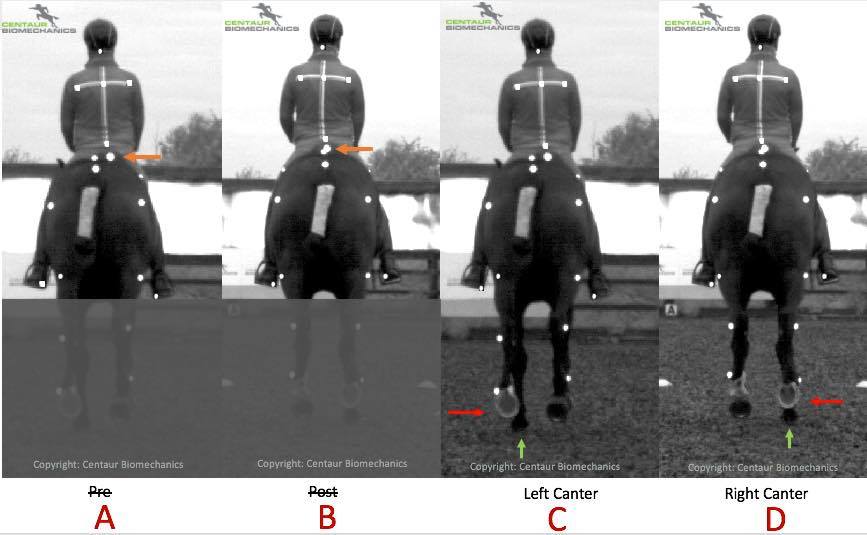
In image A, the saddle is slipped to the right (orange arrow) and the rider is shortening through their left side with their seat displaced to the right. In image B, the saddle is straighter and the rider has an improved position as a result of the “intervention” – or is this a trick….? With reference to images C and D (same as the previous images, but now the limbs are visible) it can be seen that the horse is on different canter leads (image A and C = left lead and image B and D = right lead) - look at the orientation of the hoof.
In the above scenario, riders may see these two images (A and B ) and believe the “intervention” has resolved the saddle slip and that their position is improved. The differences here, are as a function of the horse being on the opposite rein and the directional effects on locomotion and biomechanics. In addition, saddle slip generally only occurs on one rein.
Riders could be under the impression that the “intervention” has 1) resolved the saddle slip; 2) that they are responsible for the saddle slip and 3) that the intervention has worked. Of course, if the intervention has worked and has been verified (correctly with no bias) then this is a positive.
The greater concern is if riders believe an intervention has worked, and it hasn’t. In these cases, the rider is likely not to address the underlying mechanics as to why the saddle is slipping. Evidence from (Greve and Dyson), and our own (MacKechnie-Guire et al.) has shown that the horse is the contributory factor for inducing saddle slip with the rider following the movements of the saddle and horse. It is appreciated that there are a small number of riders who may induce saddle slip however, in the majority of cases it is initiated by the horse due to multiple reasons - lameness, functional asymmetry, laterality, seasonal effect, travelling etc. research is ongoing to understand further.
The purpose of this blog is to raise awareness, I recently received a pre and post image from a rider. This rider was not advised nor did she think to explore the underlying mechanics as to why the saddle had initially slipped as the intervention had “fixed” the problem. A few months later, the rider was still crooked and the saddle slip was more evident– what long term effect did this have on the horse+rider….?
Saddle slip is something that requires a detailed understanding of both equine biomechanics and the interaction between the horse, saddle and rider. Correcting saddle slip is something that requires a team approach (all or some) veterinarian, saddle fitter, farrier, coach, therapist, biomechanist, horse+rider physio etc. along with regular monitoring and saddle fitting checks. Importantly, saddle slip can be an early indicator of movement asymmetry hence it is essential that it is addressed in order to limit further asymmetries developing.
Things to look for when viewing pre and post images.
- Foot fall – you will see with image C and D the grounded limb (green arrow) and flexed hindlimb (red arrow) has been indicated – it can be seen that the grounded/flexed limb (s) differ when on either the left / right rein. This is easily identified when looking at the orientation of the hoof
- Pelvic roll / height – look at the top of the horse’s pelvis and observe if it rolls (falls away) in the same direction
- Gait – walk, trot and canter have different mechanics hence will have a different effect on the horse+rider+saddle
I hope the above post helps. I am a massive advocate of using technology to help support horse + rider performance but the interpretation of information / findings is crucial and if performed incorrectly can be misleading and in the scenario presented here, could have a detrimental effect on the horse+rider.
For meaningful comparisons to be made, the horse+rider need to be on the same rein, same moment in the stride cycle and same gait.
Please share to raise awareness.